3. Some Members of the Gibbons Family
Mr. Paul Gibbons.
Having started to describe the "Gaffer" as one who was
perhaps in the position to observe him and his family, it should be
on record just what a gentleman he was. Factory people would see him
at Christmas time driving round the back streets of Blakenhall and
All Saints road, with an envelope and a bottle of whisky for some of
his very old workmen or women, not just knocking the door and making
a swift exit but going in and chatting about old times.
Many examples of concern for his sick employees, by both his
wife and himself, can be bought to mind from one who was sometimes
involved in these unsung activities.
Another gesture by him was when he could have replaced much
of his machinery that had been worn out with war work he put country
before profit by letting others have the Government grants for
replacements, until he could afford them himself.
| Mr. Paul Gibbons gave a
party in the Civic Hall on his 50th birthday. In this photo,
from the left are: ??, ??, Miss Fayne Gibbons, Paul
Gibbons, Mrs. Gibbons, Mr. Brentnall, Mrs. Brentnall. |
 |
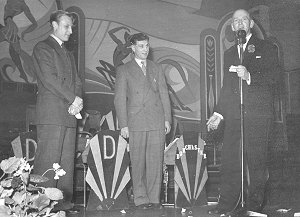 |
On stage at the party
are Ernie Bayliss at the microphone and Wolves stars Bert
Williams and Jimmy Mullen. |
| At the party a 'Little Bo
Peep' steps out of a large cake with a presentation for Mrs.
Gibbons. |
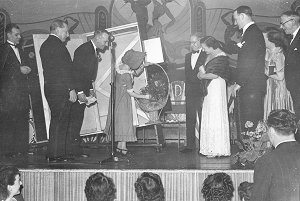 |
Mr. Tony Gibbons,
his brother, has a claim to fame that should be in the history of
the firm for people to see and read about. This is a small episode
that occurred at the beginning of the second world war, but one
which saved thousands of man hours in the aircraft industry that
was, at the time, overstretched
in production.
Aluminium had replaced fabric on the aircraft bodies and wings and
rivets of different sizes were required by the millions for
inside and outside of fighters and bombers coming off the production
lines. The greatest
problem that the engineers had was recognising the different sizes
of rivets that all looked the same in their boxes, all aluminium
colour. Also aluminium could canker, untreated.
Mr Tony, a qualified pilot himself, as well as an engineering
chemist, worked day and night on a process that would identify the
sizes at a glance.
He developed an anodising process of colouring the rivets, red,
blue, green, etc., so
now not only was the danger of the wrong sized rivets eliminated,
but unskilled labour could be used in the manufacturing and building
of aeroplanes. This process was not patented by him and a workman,
seeing an opportunity, left after the war and set up an "anodising"
factory on the Birmingham New Road and made a fortune.
Mr Tony became a ferry pilot during the war as well as working at
the Church Lane works.
Another member of the family, the brother of Mrs. Paul Gibbons, was
Major Grant, M.C., the personnel director. He, like his sister,
came from an old Scottish family domiciled at Nairn in Scotland.
Popular and understanding, he fitted into the workforce not
long after the ending of hostilities in which, serving in the
Cameron Highlanders, he was awarded the Military Cross for bravery.
Mr Paul had a daughter, Fayne.
She married Mr Hugh Meynell who later became Sheriff of
Staffordshire. They lived at
Brocton near Shifnal.
The Meynell valves factory at Bushbury exported world wide,
contributing to Wolverhampton’s production of hard brass products,
though not connected with the Gibbons firm.
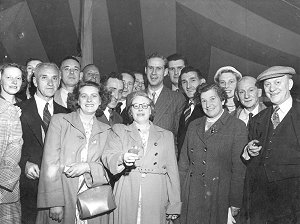 |
Hugh Meynell (the tall
man in the centre) gives a party, prior to his wedding, in a
large marquee in the gardens of Brook House. |
| A wedding photograph
with the bridge and groom's parents - the Meynells to the
left and the Gibbons to the right. |
 |
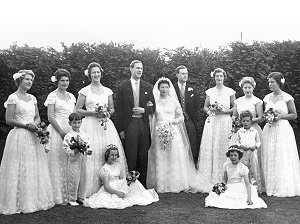 |
The bride and groom with
the best man and all the bridesmaids. |
The Queen Square Syndicate
Also unwritten on the pages of our industrial past until now, is the
fact that our industrial masters also had close family-type
relationships in their own areas of recreation.
The Queen Square Syndicate, made up of some of the most
important business families such as Manders, Grahams, Gibbons and
the like, had, in the Claverley area, a very important "shoot".
Fifty years ago this area was covered with wildlife: pheasant,
partridge and duck abounded from Wombourne to Bridgnorth and the
"Shooting Syndicate" had a vast area to shoot over.
There was a shoot sometimes twice or three times a week,
though in the main the Saturday shoot predominated.
|
Brook House, Claverley |
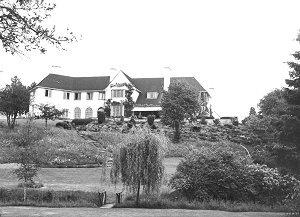 |
Each "gun" usually had a member of his workforce to accompany or
join the shoot as beater or "picker up" of the downed game.
Here the firm’s transport, in the shape of shooting
brake or Land Rover, was brought into use, with the garage
hand or foreman driving it.
The shoot was centred on Brook House, the home of Mr Paul Gibbons,
who was the accepted master of the shoot. Other places also took
turns as the meeting place, such as the "Gate" or "Woodman" and
"Oak" public houses. Mr Douglas Graham, and his then young sons
Robin and Douglas, took a leading part; the Mander brothers; Colonel
Gibbons who had the Dibdale Works at Dudley; Colonel
Elwell and Major Grant were just a few of the important people who
took part. Down the
scale were the beaters, drivers and dog handlers, some from as far
as Bridgnorth, who had to be collected before the morning start and
then returned afterwards in the dark, tired, wet and worn out but
happy to have that little extra money for the days sport, along with
a "bird" if the shoot had been a good day.
The Claverley constable would also be included with the beaters as
part of his duties, to keep an eye on known poachers in the area and
to familiarise himself with his very large beat.
Police Constable William "Bill” Hannah lived in the Police
House, Claverley. He
was very keen on a little target shooting himself, spending a few
Sundays on the old Volunteer Range at Patshull, blasting off dozens
and dozens of 303 cartridges left over from the T.A and Home Guard.
This young policeman would now be in long retirement but it
is important to record his achievement in life.
Bill became a Sergeant, then an Inspector.
He studied all of his life, became a barrister, took silk and
then became William Hannah, Circuit Judge, with a record for
commonsense in his court.
He is well remembered by the Gibbons people who were a small
part of the enjoyment had by those who took part in sport enjoyed by
both masters and men.
|